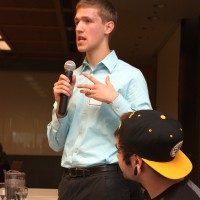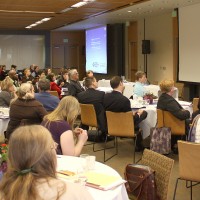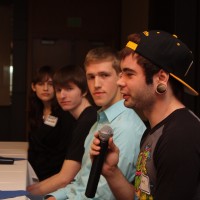This content was published: February 28, 2011. Phone numbers, email addresses, and other information may have changed.
PCC explores ways to better serve foster youth
Photos and story by James Hill
According to the Casey Family Programs in Seattle, youth in foster care have a less than 50-percent high school graduation rate and only 15 percent of them manage to enroll in a college. And, just nine percent eventually earn their college degree.
Portland Community College student Jared Morris, 19, of Southwest Portland, wants to improve those statistics. He’s in his fourth term at PCC and is trying to get his life in order after entering foster care at the age of 16.
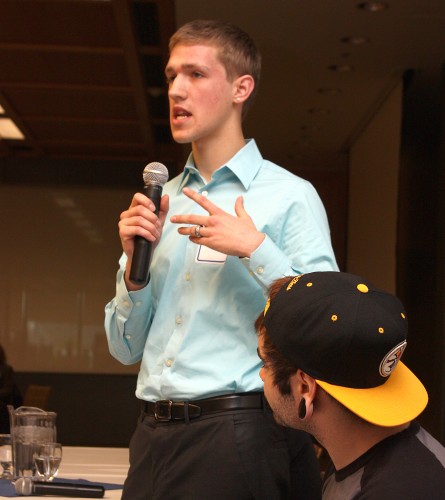
Josh Delorenzo tells his story of being in foster care and how he transitioned to college to a crowd of local educators.
“Foster care was the longest few years of my life,” Morris said. “I had no idea where I would end up. But now things are just so great.”
Morris told his story of overcoming barriers to college at a PCC-sponsored Foster Youth Summit on its Rock Creek Campus, Friday, Feb. 11. More than 110 local college representatives, including from PCC, listened to a panel of students and national experts on foster youth education.
“Community members and providers were alongside representatives from three local community colleges – Portland, Mt. Hood and Clackamas community colleges – brought together by PCC,” said Linda Blanchette, PCC staff development facilitator. “We are working together toward finding a better way to serving some of our most vulnerable students. I think this is exciting.”
The summit showed how foster youth tend to be on their own at a younger age than other kids and lack basic knowledge of college because of not having many mentors in their lives. According to the Casey report, they have college aspirations, but don’t have the preparation and lack advocates that would help them. And few college programs are aware of their needs or have services to help them.
“I didn’t think I would get anywhere and wasn’t sure I’d get my diploma,” Morris told the attendees. “I started in the GED program at PCC because I always wanted to go to college; it’s where you get ahead. But I didn’t know anything about financial aid, or how I was going to get to the campus; I had no idea. But my IOP (Youth Intensive Outpatient Program) worker told me about the financial aid process and all the grants I could qualify for as a foster youth. That just opened my eyes that college could be possible.”
Community college expert shows the way to help foster youth
David Ambroz, who is the Executive Director of Los Angeles City College Foundation and creator of its Guardian Scholars Program, headlined the summit. He established the Guardian Scholars program to provide a support structure for foster youth in making the transition from foster care to independence. It does it by connecting the youth to financial, academic, and social support that will assist them in pursuing higher education.
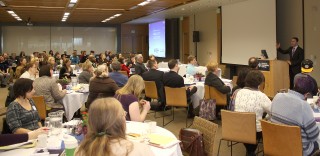
David Ambroz, who heads Los Angeles City College’s Foundation and foster youth services, gave the keynote address.
“They don’t always have the support they need at home,” Ambroz said. “It is the community college where they’ll most likely end up and, hence, need the most support.”
Ambroz, who was homeless himself in Manhattan as a youth and was in foster care, drove home the point of how many colleges aren’t aware of how many they have. When he first started at his college, he asked his administration how many foster youth go to LACC to get an idea of how large a population he was dealing with.
“They thought they had just six foster youth in a college of 220,000 students,” Ambroz said.
As he worked to modify admission forms, he was able to identify 4,000 foster youth students on his campus, not six. He then worked to get buy-in to his program from the deans, the president, administration and frontline staff.
“Somehow foster youth are expected to know what to do when they get on campus and if they even come here and enroll it’s a miracle,” he said. “We removed the barriers and implemented hand-holding support. It’s been a tremendous success.”
Most will transition to a community college
Janine Allen, Professor of Education at Portland State University, presented data from a survey that showed former foster youth’s pathway to the baccalaureate is often through the community college. According to her survey results of PCC, University of Oregon, Western Oregon, University of Portland, Portland State and Concordia students, PCC had the highest concentration of former foster youth in the Portland Metro area with 6.3 percent of its student population. The average for the survey was 4.6 percent and the lowest rate being 1.6 percent at Portland.
But PCC has plenty of help in this effort. Portland City Commissioner Dan Saltzman (a former PCC Board member) is leading the City of Portland’s efforts to improve the futures of the community’s foster youth and through the Portland Children’s Levy, is investing $1.8 Million annually in programs to help foster children succeed. In addition, Portland has begun discussions to collaborate with other governmental and non-governmental partners to improve the lives and educational futures of foster children.
This is great news for PCC students like Ashlyn Corbett, 18, who has been in foster care for 12 years and is currently transitioning out. The Tigard resident told the summit attendees that she would enroll in music classes at the Sylvania Campus this fall. But she said it’s been a struggle to figure everything out for college and wants to make sure that those who follow her get more support.
“I never had anybody telling me to get my butt up and go to school,” she said. “That I needed to get good grades and that I needed to study for tests and needed to get into college. If you get the grades you’re going to have a better future. I didn’t have somebody to push me or feed my drive. I had to find the confidence and the resources to get up and go to school and get those grades to graduate (from high school).”

